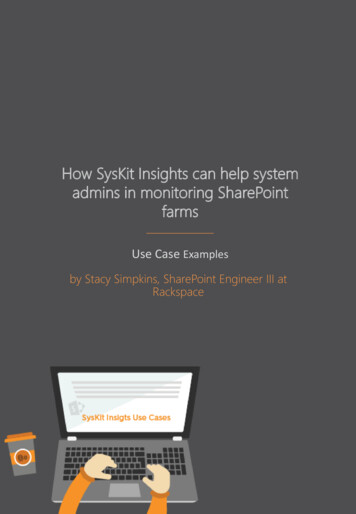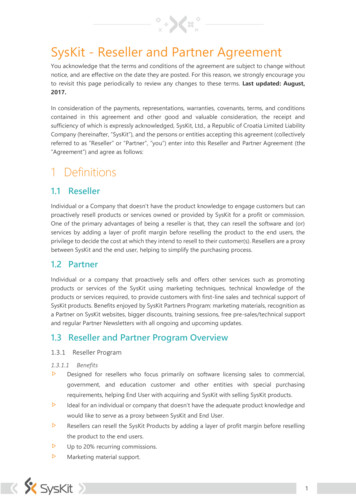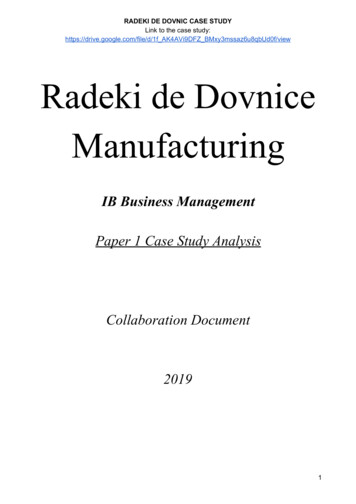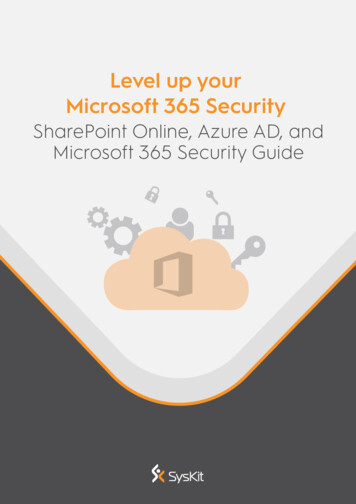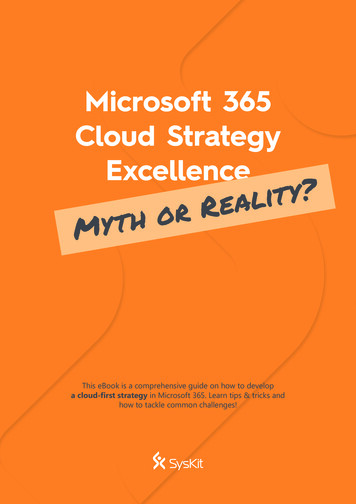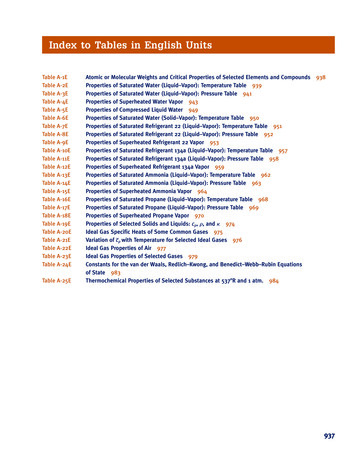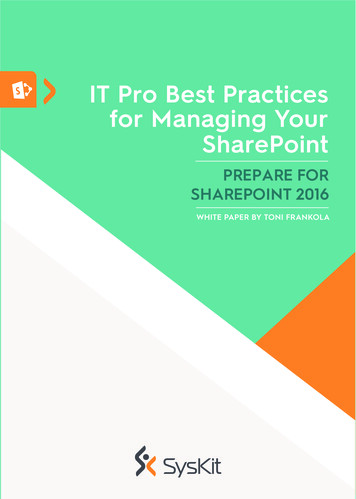
Transcription
Table of ContentsSummary. 3About the Author. 4Introduction. 5Introducing the SharePoint 2016 Feature Pack 1. 6New Features Introduced with the Release of SharePoint 2016. 8Administrative Actions Logging. 9What Does SharePoint 2016 Mean for Hybrid Environments?. 10Hybrid Taxonomy (Preview). 10Hybrid Auditing. 11Discontinued Features in SharePoint 2016. 12How to prepare for an Upgrade?. 13Database Attach Upgrade. 13How to retrieve all sites in SharePoint 2010 Before Upgrading. 14What Is New in the SharePoint 2016 Topology?. . 16Zero Downtime Patching. 17New MinRole Features and Improvements. 17Other Roles. 19Best Practices. 20Hardware. 20Upgrading to the Latest Version. 20DB Best Practices. 22Primary Drive. 23ULS Logs. 23Database Files. 24TempDB. 24Disk Allocation Size .25ModelDB. 25Maximum Degree of Parallelism. 26
Table of ContentsSQL Alias. 26Web.config Files and Solution Deployment. 27Recommended Cumulative Updates. 27Site Collection Upgrade. 28SharePoint Security. 28Site Collection Sizes. 29SharePoint Code Quality. 29Default URLs, SQL Alias, and Domain. 30Services and Proxies. 31Blog Caching Enable. 32Updating All Server. 33Claims-Based Authentication . 33Things You Are Most Likely Going to Misconfigure. 35Enable Usage and Health Data Collection. 35Site Collection Size. 36Content Database Autogrowth. 37Number of Application Pools. 37Object Cache User Account. 38Loopback Disabled. 38Publishing Cache. 39Web Application URL Check. 39Office Web Apps HTTPS. 40AppPool User in Performance Log Group. 41Conclusion. 42
SummaryThis white paper discusses SharePoint 2016 and what new functionalities it bringsto users from an architectural perspective.The second section of this white paper focuses on how SharePoint administratorscan prepare for the upgrade from SharePoint 2010 and SharePoint 2013 toSharePoint 2016 and what IT Pro best practices are when it comes to managinga SharePoint environment.Some of the new and updated features discussed in this document will be thehighly anticipated MinRole, hybrids in SharePoint 2016, compliance features,SharePoint search, and more.Among the carefully planned out preparations for migration, it is important tokeep in mind certain procedures that most users commonly forget.Because of this, the white paper outlines different SharePoint best practicesfor SharePoint on-prem and SharePoint Online before making a leap towardsupgrading to SharePoint 2016, as well as how to maintain a healthy SharePointenvironment.3
About the AuthorToniFrankolaisanentrepreneur,ITconsultant, seven-time SharePoint MVP, andMicrosoft Office Servers and Services MVP.He graduated from the Faculty of Electrical Engineering and Computing in Zagreb,where he obtained his master’s degree and gathered valuable experience indevelopment, system administration, project management, and the requirementanalysis sector.Over the years, Toni has contributed to the Microsoft community, becoming avaluable member and earning awards in multiple categories. He is a seven-timeSharePoint MVP and currently holds the title for Microsoft Office Servers andServices.Having in-depth knowledge of SharePoint administration, Toni invested his timeand expertise into starting his own company—SysKit Ltd., which he has successfullyrun for more than seven years. The company is based in Zagreb, Croatia and isthe name behind one of the most popular SharePoint admin solutions, SPDocKit.SysKit Ltd. also develops enterprise solutions, helping numerous consultants dealwith their SharePoint, Office 365, Windows Servers, Remote Desktop Services,Citrix, and SQL Server environments.4
IntroductionSharePoint 2016 brings quite a few newprem since more and more usersfeatures, as well as some updates, andare moving their environments to thefor that reason, certain preparationscloud. However, when comparing theare necessary before you start your2016 and 2007 versions, you can seeupgrade.some significant differences.It is also important to go over theRegardless of which version is beingmost common problems that baffleused,SharePointacrossSharePoint administrators get all ofthe globe as well as discuss howtheir best practices in order so that theSharePoint environment managementSharePoint environment can functioncan be improved.smoother. Thus, this white paper hasadministratorswhat isimportant isthata clear purpose: to better understandFrom an architectural perspective,what novelties SharePoint 2016 bringsSharePoint hasn’t changed drasticallyand what you should concern yourselfsince the 2010 version; although, letwith when it comes to managing yourit be noted that changes occurredenvironment.regarding the use of SharePoint on-5
Introducing the SharePoint2016 Feature Pack 1Since the release of SharePoint 2016 in March 2016, a lot of new features havebeen introduced, with its main focus on IT pro stuff, especially in relation toSharePoint Online.Microsoft has followed with additional public updates that have been announcedevery month. With the release of the SharePoint 2016 Feature Pack 1, you will getcumulative updates each month.In this section, we will try to point out some of the most important novelties andwhat to look out for when implementing them.This arrangement with feature packs is completely new to SharePoint. In fact, theFeature Pack 1 is the first time that SharePoint has provided new features withoutusers having to upgrade to an entirely new version of SharePoint. You can seejust how much it has changed since the time when cumulative updates werecoming out every two months.The innovations that are coming directly to SharePoint Online are the currentfocus of Microsoft’s plans, and it is focusing on a proper way to deliver these newfeatures to on-prem users.6
As for SharePoint in general, Microsoft plans to continue with major releasesevery two years, release new updates every month, and offer a new FeaturePack roughly once a year.Where we are now?SharePoint2016(Mar 2016) PUFeaturePack 1(PU)PUPUSharePointSharePoint 2016 hasa converged code basethat serves both cloud andon premises customers.FeaturePack 2(H2 2017)PUPUPUMajor releases remain on atraditional 2-3 year release cycle.ReleaseFrequencySECURITY UPDATEAs requiredPUBLIC UPDATEMonthlyMAJOR RELEASEEvery 2-3 yearsContentsNew features7
New Features Introduced with theRelease of SharePoint 2016 FeaturePack 1What’s new with the 2016 Feature Pack:Administrative actions logging for common SharePointadministrative actionsMinRole enhancements to support small and medium-sized farmsOneDrive for Business modern experienceCustom tiles in the SharePoint app launcherSharePoint hybrid auditing unified across site collectionon-premises and Office 365Hybrid taxonomy unified across on-premises and Office 365OneDrive API for SharePoint on-premisesNow, what is important to SharePoint administrators is questioning how thesenew features affect their environment. How do you plan for deployment? Hybridenvironments pose an important question.If you’re wondering whether you can get Feature Pack 1 for SharePoint 2013, youcannot. Only SharePoint 2016 is available.As previously mentioned, there are a lot of new features. Some worth mentioningare the MinRole, which will be discussed in further detail later on; new controlsfor working with OneDrive for Business; Site Folders view; customized web parts;document and library accessibility; Information Rights Management; EncryptedConnections; SharePoint business intelligence; and more.8
We should mention some other things that have been improved when it comesto end users and user interface.Microsoft also offers the ability to connect all the audit logs stored into SharePointon-prem with the Office 365 environment. This means you can sync these logs intoyour Office 365, giving users access to the search engine for all logs as well asthe ability to search all events and analyze them. In order to use this feature, youneed to have Office 365 and then connect it with your on-premise installation.Just a quick warning for this feature: although it has been shipped as part of theFeature Pack 1, it’s still in preview and not yet ready for production.Administrative Actions LoggingIn reference to the auditing feature, SysKit Ltd. worked with administratorsmanaging large SharePoint farms, and what we realized years back is that thefeature our clients wanted most was actually the ability to track changes; forexample, changes made in the Central Administration. Today more than ever,users find it important to keep track of users who delete, modify, and in any way,change the content.SysKit Ltd. came up with SPDocKit and developed a feature able to track changesmade in farm configuration, web applications, permissions, and web.configfiles. This is one of the features that revolutionized the way you now manageyour environment. For this reason, our tool, SPDocKit, became popular, helpingnumerous SharePoint administrators and consultants around the world.The 2016 Feature Pack 1 brings an auditing feature that can tell you exactly whohas made changes in the Central Administration. SPDocKit offers full support forFeature Pack 1 so you can view this report in SPDocKit application. In addition,,SPDocKit enables you to take snapshots of current farm settings and store themfor future comparison.9
What Does SharePoint 2016 Meanfor Hybrid Environments?Today, we can see an increase in hybrid environments, and configuring suchenvironments is now a lot easier than it was a few years ago.When we talk about hybrids, SharePoint 2016 brings good news by improvinghybrid abilities.1 Microsoft has put a lot of work into developing a hybridconfiguration that would make such an environment easier to handle. Hybridenvironments are useful in scenarios where part of your environment is on-prem,such an internal collaboration site, while a segment of it is stored in the SharePointOnline environment; for example, provisioning a part of the infrastructure inSharePoint Online for a specific project that you have been working on withanother company.Hybrid Taxonomy (Preview)Hybrid taxonomy is a solution intended to create and maintain a sharedtaxonomy between SharePoint on-premises and a SharePoint Online tenant.With an updated taxonomy in SharePoint Online, changes are automaticallypropagated across all site collections and lists.The key element in every hybrid environment is the hybrid sites, making it possibleto have sites both on-prem and online. Microsoft made it possible to sync profilesbetween SharePoint on-prem and SharePoint Online. You can even connectOneDrive to a hybrid OneDrive.An interesting new feature is the hybrid search: the ability to search bothenvironments at the same time, which is very useful if you are not sure whereyour site is located. Other features that might interest hybrid users include Office365 profiles and Hybrid Follow.21Julien Stroheker & Nicolas Georgeault, SharePoint and Office 365 hybrid configuration from A to spstoronto-2015)2Graham Gillen, SharePoint 2016 Hybrid Search: “One Search to Rule Them t-2016-hybrid-search10
There is also a feature that offers the ability to connect to Term Stores, meaningyou can now have a single Term Store across the entire environment, bothSharePoint on-prem and SharePoint Online. This could be useful, for example, ifyou have unified taxonomy on both environments. This feature is also in previewat this moment, so if you are planning on using it, make sure you test it out first.Hybrid AuditingHybrid Auditing is a new feature that came with the SharePoint 2016 FeaturePack. This feature allows users to upload their SharePoint diagnostic and usagelogs and have reports generated for them in Office 365.3 Hybrid Auditing inSharePoint 2016 is done via the Microsoft SharePoint Insight service; however, thefeature is still in preview and is not recommended for current use in the productionenvironment. Refer to this Microsoft TechNet article to find out how to configureSharePoint Hybrid Auditing in SharePoint 2016.4SharePoint Hybrid Auditing (Preview): 70(v office.16).aspxSharePoint Hybrid Auditing in SharePoint 2016: 71(v office.16).aspx3411
Discontinued Features in SharePoint 2016Of course, when certain new features surface, there are features that also getdiscontinued. That is not a problem by itself; however, it tends to become aproblem when upgrading. For example, users upgrading from SharePoint 2013may not be able to use specific features once they migrate to SharePoint 2016.Therefore, a lot of attention and detail need to be put into upgrades.Features that will not be available in the SharePoint 2016 are as follows:SharePoint FoundationStandalone Install modeForeFront Identity Manager client (FIM)Excel Services in SharePointSharePoint BI capabilities (SQL2016)Tags and NotesSharePoint DesignerInfoPathDue to these discontinued features, you may encounter a hiccup if you havebeen running SharePoint Foundations. Also, it will not be possible for you to installSharePoint as a standalone install, meaning you will not be able to auto-provisionthe SQL Server (that option was available with SharePoint 2013 and SharePoint2010).Now, for SharePoint Designer, you have an option to use SharePoint Designer2013 with SharePoint 2016 and SharePoint Online, although you should avoid thiswhenever possible. A good piece of advice would be to focus on upcomingfeatures to upgrade existing workloads, such as PowerApp, Flow, SharePointFramework, and others.12
How to prepare for an Upgrade?Before you can upgrade to SharePoint 2016, you need to make sure you arerunning an adequate version of SharePoint 2013.SharePoint Server 2016 supports an upgrade from SharePoint Server 2013 withService Pack 1 with the March 2013 PU, version 15.0.4481.1005 or higher.Even if you don’t plan on moving to SharePoint 2016 at the moment, you still needto lay out a plan and prepare your environment for the upgrade because yourcurrent SharePoint needs to be up to date to upgrade.Database Attach UpgradeThe only available way to upgrade from Microsoft is the database attach.Once you have SharePoint 2013 that is on version 15.0.4481.1005, you need totake the database and attach it to a new farm—in this case, a SharePoint 2016farm and then you will be able to upgrade. The other way is to contact a thirdparty migration vendor and migrate your content to a new database. By usinga migration tool, you will not be stuck with upgrading to Service Pack 1, and youcan also upgrade from an earlier version of SharePoint like SharePoint 2010.When creating a new farm, we would also recommend you use the AutoSPInstaller5script that will prepare and install everything so you don’t have to bother withthe process. AutoSPInstaller is an open-source project and, by joining forceswith the SPDocKit, it helps SharePoint administrators provision SharePoint farmsautomatically. With SPDocKit, you can generate the input XML configuration filethat you can use with AutoSPInstaller and create a new SharePoint farm that isidentical or very similar to your current farm environment.AutoSPInstaller available online at: https://autospinstaller.com/513
This input from SPDocKit is an XML file that contains farm topology as well asother details about the SharePoint farm. The configuration file reduces the timeneeded to deploy SharePoint, and since everything is reusable, you can createproduction and staging/testing environments that are identical.A tool such as the AutoSPInstaller is very useful, especially in cases where youhave multiple SharePoint farms, such as DEV, QA, TEST, etc. Then, you can usethe same script to auto-provision farms and tidy up your environment. Note thatyour databases names are not going to have those horrible GUIDs, and thenames are going to follow the naming convention of your choice.How to retrieve all sites in SharePoint 2010Before UpgradingIf you are doing a database attach yourself, and we cannot stress this enough,make sure you are on a proper version.If you recall, when we upgraded from SharePoint 2010 to SharePoint 2013, therewas the ability to retain the 2010 look and feel and still run it on a SharePoint 2013server. Sadly, this is no longer supported in SharePoint 2016. That is why you mustmake sure you have converted all sites to the SharePoint 2013 user interface.There is no concept of “site collection compatibility modes” in SharePoint Server2016. You must be running the latest version at all times.If you have a SharePoint environment that was upgraded from SharePoint 2010to 2013, the following is the PowerShell command that can be used to retrieve allsites that are still in the SharePoint 2010 mode.14
You can use the following commands to get more information on the compatibilitylevel:Get-SPSite -Limit All ? { .CompatibilityLevel -eq 14 }Get-SPSite -ContentDatabase database name -Limit All ? { .CompatibilityLevel -eq 14 }Once you retrieve all the sites, you will need to upgrade these before proceedingwith the upgrade to 2016.15
What Is New in the SharePoint2016 Topology?A typical topology for SharePoint 2013 and earlier versions as well would looklike this: you would have Web Front End servers, and we have only two in mycase; then a layer of Application servers; and, finally, a couple of SQL Servers.Of course, you might also have additional servers, like Search server or Cacheserver.6Now, the SharePoint 2016 topology has MinRoles, which come out of the boxand look like this:Front-EndService applications, services, and components that serveuser requests belong on a Front-end server. These servers areoptimized for high performance.ApplicationService applications, services, and components that serveback-end requests, such as search crawl requests, belong onan Application server. These servers are optimized for highthroughput.Distributed CacheService applications, services, and components that are requiredfor a distributed cache belong on a Distributed Cache server.SearchService applications, services, and components that are requiredfor search belong on a Search server.CustomService applications, services, and components that you want tomanage, instead of using MinRole to manage them, belong on aCustom server.6Planning for a MinRole server deployment in SharePoint Server 2016: 04(v office.16).aspx616
So what in fact you have is a Web Front End that handles all the user interaction,Application role that handles all the background tasks, Distributed Cache thatcaches all the components, and a Search role.This means SharePoint 2016 has four key roles and you can configure them byclicking on a server and assigning it a certain role. What happens then is thatSharePoint turns off all features that are not necessary for the chosen role, andit switches the services for that particular role as well. This is not hardcoded andyou can change that as you please. Of course, there are rules that check theseroles all the time, and configure the services as they run.Zero Downtime patchingThe MinRole is important when it comes to zero downtime patching. It allows youto deploy updates and fixes while minimizing downtime and user disruption.When you had SharePoint 2013 or SharePoint 2010, it was a challenge to createan internal procedure that would allow you to patch your SharePoint and stillhave zero downtime. Changes that are being made with MinRoles are going toallow you to patch your SharePoint with zero downtime.Now that we have concluded that a SharePoint 2016 farm needs at least fourservers to run it, if you want to have a zero downtime patching, you might considergetting eight servers into your farm. That way, you can have a copy of each ofyour four servers with their unique roles in order to patch it with a zero downtime.New MinRole Features and ImprovementsWith MinRoles, you needed a lot of servers to run, and that is why in Feature Pack1 of SharePoint 2016, Microsoft has changed that a little bit and introduced17
improvements to support small environments—something that the communityaffectionately calls the Mini MinRole.Now you are getting two additional roles: Microsoft combined roles for smallerinstallations for companies that do not need eight servers to run a SharePointfarm and added combined roles.The new combined role is a Web Front End with a distributed cache; it combinesWeb Front End and Distributed Cache, and the other combines Application withSearch. Now, you can run your SharePoint farm with just two servers. However, ifyou want to have higher availability, you will still need four servers.To configure roles, navigate to the configuration wizard, and the wizard will askyou which server role you wish to assign to which server. For typical Mini MinRolespatching, you only need four servers to have a zero downtime patching, andonce one server goes offline, the other one will handle all tasks and so on andso forth.Figure 1 - SharePoint 2016 Products Configuration Wizard18
Basically if you want to have higher availability, you should go with four servers asa minimal topology, although, as mentioned earlier, it is possible to run SharePoint2016 with just two.The bottom line is that the Mini MinRoles are the most important changes whenit comes to SharePoint 2016, and this is something that you need to plan aheadfor by making calculations for how many servers you need and how many rolesyou are going to provision.Other rolesOne special role is the Custom role, and this role can be configured in any wayyou please. Basically, you can configure it to run as any role; for example, ascustom services. What’s important is that this role is not controlled by specificrules like the remaining four we mentioned in the previous section.Also, there are some special roles, such as the single server farm, which are usedfor development and testing only and are not meant to be used as production. Thismeans that SharePoint in production does not support a single server scenariobecause you need more than one server to run the production SharePoint farm.19
Best PracticesWhen it comes to upgrading, there are certain best practices that help youtransition to the new SharePoint version rather quickly.HardwareIn regard to hardware for SharePoint 2016, there is no significant change;requirements are similar to those in 2013 and are as shown below:SCENARIORAMPROCESSORHARD DISK SPACESingle serverrole that usesSQL Server16GB64 BIT, 1 CORE80 GB for system drive100 GB for second driveSingle serverrole that usesSQL Server24GB64 BIT, 2 CORES80 GB for system drive100 GB for second driveand additional drivesWeb Server orapplicationse rver in ath ree-tier farm12GB64 BIT, 1 CORE80 GB for system drive80 GB for second driveWeb Server orapplicationse rver in ath ree-tier farm16GB64 BIT, 4 CORES80 GB for system drive80 GB for second driveand additional drivesUpgrading to the Latest VersionFirstly, if you are planning to upgrade to the next major release of SharePoint,make sure your existing environment is running a version of SharePoint thatsupports upgrades. Then, check that you have a proper build number, and sincethese numbers are hard to track down on the Internet, we will list them on thenext page.20
Upgrade from SharePoint 2007 to 2010, minimal build:SharePoint 2007 SP2, build number (12.0.6421.1000)Upgrade from SharePoint 2010 to 2013
can prepare for the upgrade from SharePoint 2010 and SharePoint 2013 to SharePoint 2016 and what IT Pro best practices are when it comes to managing a SharePoint environment. Some of the new and updated features discussed in this document will be the highly anticipated MinRole, hybrids in SharePoint 2016, compliance features,

